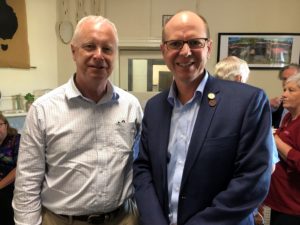 Bushfire Royal Commission Chair Air Chief Marshal Mark Binskin and AFPA CEO Ross Hampton
Bushfire Royal Commission Chair Air Chief Marshal Mark Binskin and AFPA CEO Ross Hampton
The Australian Forest Products Association today told the Royal Commission into Natural Disaster
Arrangements that key forestry assets such as the NSW Southwest Slopes’ softwood plantations, which
support the biggest economic sector in the region, should be considered critical infrastructure
when allocating firefighting and fire mitigation resources.
At a community forum in Tumbarumba today held by the Royal Commission, AFPA CEO Mr Ross Hampton told the Royal Commission’s Chair Air Chief Marshal Mark Binskin that there must be a
whole-of-landscape approach to bushfire mitigation and land management, and more aggressive fuel
reduction that includes mechanical fuel reduction alongside controlled burns.
“The current system where there are multiple approaches to fuel reduction by multiple land managers
and agencies isn’t working and we need a more coordinated approach,” Mr Hampton said.
“I commend the Federal Government for including in the terms of reference for the Royal Commission
“the preparedness and resilience responsibilities, which includes land management and hazard
reduction measures’, which gives the Commissioners the scope to closely examine this issue.”
Mr Hampton said while bushfires were unavoidable, more fuel reduction that included mechanical fuel
reduction to create buffers around towns and critical infrastructure would make it easier to
suppress catastrophic fires.
“The softwood plantation-based industry is the biggest employer in this region, supporting nearly
$2 billion of economic activity in the region and employs around 5000 people, but with up to 40 per
cent of region’s softwood estate damaged by the fires there will be a significant impact on the
industry for at least the next 15 years,” Mr Hampton said.
“While saving lives must be the priority for firefighting resources, we must also redefine critical
infrastructure to include key economic assets such as forestry plantations because they are the
economic backbone of many regional communities, and they can take decades to recover. This should
apply not just to the deployment of fire mitigation and suppression resources, but also recovery
funding.
Mr Hampton welcomed the NSW Government’s announcement this week of a $46 million equity injection into Forestry Corporation of NSW is a welcome first step to aid the state’s forest industries
recovery from the bushfires.
“The replanting effort, the recovery of burnt timber and the increased freight costs facing the
industry are significant and we are working with the NSW and Federal Governments to manage these
challenges – we hope to see further announcements to support the massive recovery effort needed in
NSW, Victoria and South Australia,” Mr Hampton said.
AFPA recently released a report, Using Fire and Machines to Better Fire-Proof Our Country Towns.








